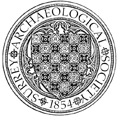North Park Quarry
Watching brief and subsequent detailed archaeological excavation by G Santamaria of WA to the north and east of previous phases of work (figs 6 and 7) and an exploratory machine slot excavated through a possible palaeochannel revealed but not investigated during the 2015 season. The possible palaeochannel measured c 40m in width but was relatively shallow, at a maximum of 2m to the underlying sand (fig 8).


